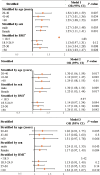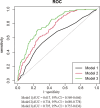Association between serum globulins and diabetes mellitus in American latent tuberculosis infection patients: A cross-sectional study
- PMID: 39465722
- PMCID: PMC11460894
- DOI: 10.1097/MD.0000000000039949
Association between serum globulins and diabetes mellitus in American latent tuberculosis infection patients: A cross-sectional study
Abstract
Diabetes mellitus (DM) is predisposing to the development of latent tuberculosis infection (LTBI). An understanding of the underlying factors of LTBI-DM is important for tuberculosis prevention and control. This study aims to evaluate the association between LTBI and DM among the noninstitutionalized civilian population in the United States, focusing on the impact of serum globulins. We performed a cross-sectional study design using public data from 2011 to 2012 National Health and Nutrition Examination Survey, focusing on participants diagnosed with LTBI who were aged 20 and above. Weighted Wilcoxon rank-sum and weighted chi-square tests were used to compare group differences. A multivariable logistic regression model was constructed to assess the association between serum globulin and DM, with subgroup analyses and evaluations of nonlinear relationships. Receiver operating characteristic curves were used to assess the predictive power of the models. A total of 694 participants (512 DM and 182 nonDM) were included in our study and the incidence of DM was 22%. Higher serum globulin levels were significantly associated with an increased risk of DM, with a 21% increase in risk for each unit increase in serum globulin (odds ratio = 1.21, 95% confidence interval [1.03, 1.43], P < .001). The relationship between serum globulin and DM was linear, and higher serum globulin levels were associated with a higher risk of DM, particularly in males (P = .043) and obese individuals (P = .019). The area under the curve for serum globulin predicting DM was 0.795, with an optimal cutoff value of 2.9. Elevated serum globulin levels are significantly associated with an increased risk of DM among individuals with LTBI, highlighting the potential role of serum globulin as a predictive biomarker for DM in this population. However, the specific mechanism between globulin and LTBI-DM needs to be further investigated.
Copyright © 2024 the Author(s). Published by Wolters Kluwer Health, Inc.
Conflict of interest statement
The authors have no conflicts of interest to disclose.
Figures




Similar articles
-
Circulating Aryl Hydrocarbon Receptor Is Associated with Latent Tuberculosis Infection in Patients with Type 2 Diabetes.Int J Mol Sci. 2025 Jun 4;26(11):5384. doi: 10.3390/ijms26115384. Int J Mol Sci. 2025. PMID: 40508196 Free PMC article.
-
Diabetes mellitus and latent tuberculosis infection: an updated meta-analysis and systematic review.BMC Infect Dis. 2023 Nov 8;23(1):770. doi: 10.1186/s12879-023-08775-y. BMC Infect Dis. 2023. PMID: 37940866 Free PMC article.
-
Higher blood manganese level associated with increased risk of adult latent tuberculosis infection in the US population.Front Public Health. 2024 Jul 24;12:1440287. doi: 10.3389/fpubh.2024.1440287. eCollection 2024. Front Public Health. 2024. PMID: 39114509 Free PMC article.
-
Epidemiology of latent tuberculosis infection among patients with and without diabetes mellitus.Fam Pract. 2017 Sep 1;34(5):532-538. doi: 10.1093/fampra/cmx017. Fam Pract. 2017. PMID: 28369346
-
Accuracy of interferon-γ-induced protein 10 for diagnosing latent tuberculosis infection: a systematic review and meta-analysis.Clin Microbiol Infect. 2019 Jun;25(6):667-672. doi: 10.1016/j.cmi.2018.12.006. Epub 2018 Dec 14. Clin Microbiol Infect. 2019. PMID: 30553864
References
-
- Ogurtsova K, da Rocha Fernandes JD, Huang Y, et al. . IDF Diabetes Atlas: Global estimates for the prevalence of diabetes for 2015 and 2040. Diabetes Res Clin Pract. 2017;128:40–50. - PubMed
-
- Lönnroth K, Roglic G, Harries AD. Improving tuberculosis prevention and care through addressing the global diabetes epidemic: from evidence to policy and practice. Lancet Diabetes Endocrinol. 2014;2:730–9. - PubMed
Publication types
MeSH terms
Substances
Grants and funding
LinkOut - more resources
Full Text Sources
Medical

